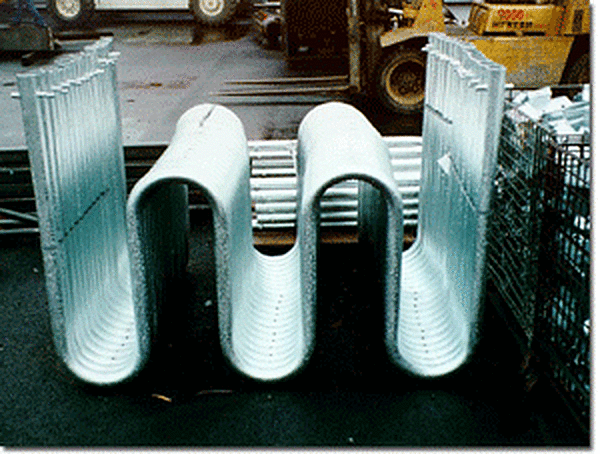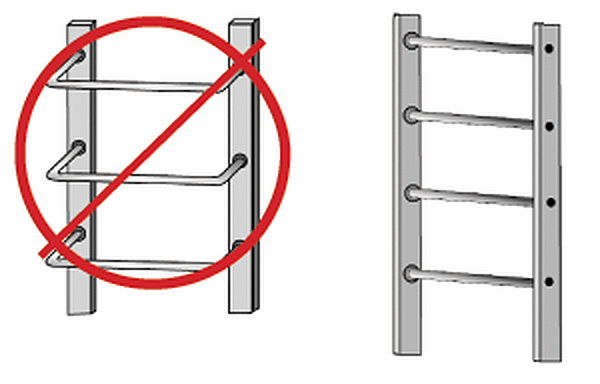Cold Worked Steels

Many structures and parts are fabricated using cold-working techniques (bending, hole-punching, rolling, shearing). Severe cold-working increases the incidence of strain-age embrittlement. The effects of strain-age embrittlement may be accelerated by the galvanizing process, because aging is relatively slow at ambient temperatures but more rapid at the elevated temperatures encountered in the galvanizing process. (See also Bend Diameters).
Any form of cold-working reduces steel's ductility. Operations such as punching holes, notching, producing fillets of small radii, shearing, or sharp bending may lead to strain-age embrittlement of susceptible steels. Cold-worked steels less than 1/8" (3 mm) thick subsequently galvanized are unlikely to experience strain-age embrittlement. Since cold-working is the strongest contributing factor to the embrittlement of galvanized steel, these tips are recommended to reduce the incidence of strain-age embrittlement:

- Select steels with carbon contents below 0.25%.
- Choose steels with low transition temperatures since cold-working raises the ductile-brittle transition temperature and galvanizing (heating) may raise it further.
- Specify aluminum-killed steels; they show less susceptibility to strain-age embrittlement.
- For steels with a carbon content between 0.1% and 0.25%, maintain a bending radius of at least three times (3x) the section thickness. If bending is required to be less than 3x, the material should be stress-relieved at 1100 F (595 C) for one hour per inch (2.5 cm) of section thickness.
- Avoid notches - they increase stress. Notches may be caused during shearing or punching operations. Flame-cutting or sawing is preferred, particularly for heavy sections.
- Drill, rather than punch, holes in material thicker than 3/4" (19 mm). If holes are punched, they should be punched undersize and then reamed an additional 1/8" (3 mm) overall or drilled to size. Material between 1/4" and 3/4" (6.5 - 19 mm) thick is not seriously affected by cold punching if the punching is done under good shop practice. Material up to 1/4" (6.5 mm) thick that has been cold-worked by punching does not need stress-relieving before galvanizing.
- For steel sections with edges greater than 5/8" (16 mm) thick subject to tensile loads, cut using normal shop procedures. Edges of sections up to 5/8" (16 mm) thick may be cut by shearing.
- In critical applications, the steel should be hot-worked above 1200 F (650 C) in accordance with the steel manufacturer's recommendations. Where cold-working cannot be avoided, stress-relieve the part.
Where cold-working cannot be avoided, stress-relieve the part at 1100 F (593 C) for one hour per inch (2.5 cm) of material thickness. ASTM A143, Safeguarding Against Embrittlement of Hot-Dip Galvanized Structural Steel Products and Procedure for Detecting Embrittlement, and CSA Specification G164, Hot-Dip Galvanizing of Irregularly Shaped Articles, provide guidance on cold-working and stress-relieving procedures. However, it is best to avoid severe cold-working of susceptible steels. If there is concern with possible loss of ductility due to strainage embrittlement, advise your galvanizer. A sample quantity of the cold-formed items should be galvanized and tested before further commitment.
Cold-working also must be taken into consideration with respect to another potential mechanical change that may occur during galvanizing's chemical cleaning process: hydrogen embrittlement. During the chemical reaction between steel, rust, and the chemicals used in the pickling stages of the galvanizing process, hydrogen is produced, which is then absorbed by the steel. Upon immersion into the molten zinc, the hydrogen is expelled as gas. If the steel has been severely cold-worked in a very small region, the hydrogen can be trapped in the steel, causing hydrogen embrittlement when the part is put under stress during use.
Hydrogen embrittlement is of concern only when the ultimate localized tensile strength of the cold-worked steel exceeds 170 ksi (1,200 MPa). Mechanically cleaning of localized high-strength steel areas avoids hydrogen embrittlement.
